Friday 31 August, 2007, 10:48 - Pirate/Clandestine
Posted by Administrator
Since the late 1990's rumours have abounded that it was possible to hack into American military satellites and use them for wide area communication. The satellites, originally the 'FleetSatCom' newtork (often abbreviated to FLTSATCOM) use basic FM modulation and have uplinks in the area of 300 MHz and downlinks in the area of 260 MHz. Stories went that tuning in to the downlinks it was possible to hear illegal pirates, from Brazil in particular, who were usurping these US military satellites to use for wide-area communications. It was also said that 'Smile 93.9 FM' (rumoured to be from Manila) was using one of the channels as a studio to transmitter link and could often be heard on the downlink frequency of 269.950 MHz.Posted by Administrator
This seemed a little far fetched and unbelievable: How could one of the world's most super-sophisticated armed forces allow their multi-million dollar military hardware be taken control of by such an unsophisticated enemy armed with nothing more than a simple UHF FM transmitter? Using a simple VHF/UHF receiver and a bog standard roof mounted VHF/UHF antenna, I set out to try and debunk the myth.
Within seconds I was listening to a conversation between two likely sounding chaps on a frequency of 255.550 MHz. Next I stumbled across more voice traffic (definitely in Portuguese, the language spoken in Brazil) on 258.650 MHz. And before long I found more voice traffic on 253.850 MHz. Intrigued that this long reported phenomena was still in evidence I did a bit of digging on the internet to find out more.
The original FleetSatCom satellites which were launched in the late 1970's and early 1980's are no longer operational. They were initially replaced by satellites known as Leased Satellites (Leasat) which have also since been replaced by the UHF Follow-On series of satellites, ironically acronymised as UFO. The UFO satellites continue to provide the same communications capabilities as the earlier ones but with somewhat higher transmitter powers, making reception of them fairly straightforward.
A bit more digging uncovered military standard MIL-STD-188-181A which describes the interface specification for the satellites (i.e. the technical requirements for equipment used to access them) and in it we find a list of the uplink and downlink frequencies used. All the frequencies I could hear are in group 'Charlie', now known as group 'Quebec' (Q) on the UFO satellites. Group Q comprises the following 25 kHz wide downlink frequencies (uplink frequencies are 41 MHz higher):
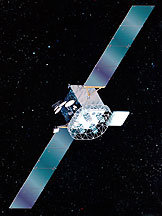 Q1 250.650 MHz (Fleet Broadcast)
Q1 250.650 MHz (Fleet Broadcast)Q2 252.150 MHz (Navy Channels)
Q3 253.850 MHz
Q4 255.550 MHz
Q5 257.150 MHz
Q6 258.650 MHz
Q7 265.550 MHz
Q8 267.050 MHz
Q9 269.450 MHz
Q10 269.950 MHz
Q11 260.625 MHz (DoD Channels)
Q12 260.725 MHz
Q13 262.125 MHz
Q14 262.225 MHz
Q15 262.325 MHz
Q16 262.425 MHz
Q17 263.825 MHz
Q18 263.925 MHz
So far, I have heard sporadic voice traffic on channels Q2, Q3, Q4, Q5 and Q6 and something, albeit rather weak on Q7. It seems as if the satellite I am hearing is UFO-7 which is situated over the Atlantic. But is this traffic really pirates using the satellites on purpose, or is it something else? Surely there is no longer the need, in Brazil or other countries, to use US military satellites for communications, especially now that mobile phones and mobile coverage are virtually ubiquitous?
A quick look at the Brazilian frequency allocation table, the Plano de Destinação de Faixas de Freqüência, shows us that the frequency range 270 - 326.8 MHz is assigned to the fixed and mobile service, and in particular to public correspondence. So the frequencies are quite legally in use for various communication services; could it be that they are being relayed by the satellite is incidental and a result of the fact that the uplink frequencies are used differently in different parts of the world? So maybe there are no Brazilian pirate radio mafia trying to jam US military satellites after all then? What a shame, it seemed like such a good story.
5 comments
( 6802 views )
| permalink
| 



 ( 3.1 / 22702 )
( 3.1 / 22702 )




 ( 3.1 / 22702 )
( 3.1 / 22702 )
Wednesday 16 May, 2007, 14:14 - Pirate/Clandestine
 There's a term used in the UK which takes its roots from an overgarment worn by many to keep dry on particularly squally days. The aforementioned garment is an 'Anorak', which is a kind of winter jacket which, no matter what you wear it with, will never look fashionable (the possible exception being Paddington Bear who at least looked cute, though it could be argued that Paddington wore a Duffle Coat rather than an Anorak if we're being pernickety). The Anorak is generally rather unpopular, being an ugly but practical kind of a coat; but due to the fact that it is a rather warm item to wear, those who spend a lot of time outdoors but do no exercise and thus are in need of something to stop them freezing whilst standing around have taken the Anorak to heart as their overcoat of choice.
There's a term used in the UK which takes its roots from an overgarment worn by many to keep dry on particularly squally days. The aforementioned garment is an 'Anorak', which is a kind of winter jacket which, no matter what you wear it with, will never look fashionable (the possible exception being Paddington Bear who at least looked cute, though it could be argued that Paddington wore a Duffle Coat rather than an Anorak if we're being pernickety). The Anorak is generally rather unpopular, being an ugly but practical kind of a coat; but due to the fact that it is a rather warm item to wear, those who spend a lot of time outdoors but do no exercise and thus are in need of something to stop them freezing whilst standing around have taken the Anorak to heart as their overcoat of choice. But who, I hear you ask, would want to spend all day standing around doing nothing especially if it was cold or raining? A very good question! The Anorak became (and to some extent still is) the de facto uniform of those with hobbies such as train, bus or plane spotting, collecting number plates, "Oooh, V355LOX, a rare one from the OX series when they misprinted the 5 so that it looks like an S and it reads 'V35 SLOX'", watching grass grow, and so on... In the UK, however, the term 'Anorak' has come to be associated with anyone whose hobby is just a little bit weird, sits in a niche so small that only a handful of people understand it, is a touch excentric or is just very, very dull. And thus, most avid radio listeners, especially short wave listeners, DXers and even radio amateurs are regularly tarred with the Anorak moniker.
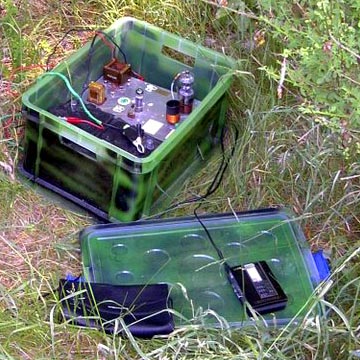 Why is this of much (if any) interest? Well the picture on the right (click it to see it in its full glory), which is a rather splendid example of a clandestine pirate radio transmitter, designed to transmit music programmes on short wave, brought me to thinking about why the stalwarts who built and operated such things continued to do so. I can think of 2000 or more salient reasons why it's no longer such a good idea:
Why is this of much (if any) interest? Well the picture on the right (click it to see it in its full glory), which is a rather splendid example of a clandestine pirate radio transmitter, designed to transmit music programmes on short wave, brought me to thinking about why the stalwarts who built and operated such things continued to do so. I can think of 2000 or more salient reasons why it's no longer such a good idea:1. No one (except Anoraks - see above) listens to short wave any more.
2. In most locations, the amount of background noise from computers, electrical equipment and the like makes short wave reception virtually impossible.
3. That aside, short wave reception does not lend itself to listening to music due to the annoying fading in and out.
4. If you want people to hear your radio presenting skills, there are easier and cheaper way of doing it - just upload a programme onto the internet.
5. There are 15,000 better things to do with your time (like collecting number plates for example).
6. If you get caught, the fines can be large (GBP2,000 plus 6 months in gaol).
7. And so on...
So why do the operators stations such as AlfaLima and WR International continue to spending their hard earnt cash and wasting their weekends building, setting up and operating such equipment. I would venture to suggest that there's still a real buzz associated with doing so. For a start, it's illegal, and flouting the law often gets the adrenalin flowing (not that I'd know of course). Then there's the kudos you get by being received by other short wave anoraks, 'Radio Flump was sounding hot last Sunday morning - SINPO 32232 - Best signal yet - I could almost make out what DJ Bobbisox was saying'. Also there's a little bit of exhibitionism and showing off in it, and that too provides an ego boost all of its own.
I argue, therefore, that the real anoraks are those people who tune into and listen to such short wave pirate broadcasts but make no attempt to join in the real fun and build a transmitter and get on air with the pioneers, pirates and thrillseekers who supply their fun to start with. So instead of tuning around the band, get your soldering iron out and build a Grenade or a Corsair, record a rubbish radio programme full of music that you think is cool but everyone else has forgotten, find a remote location, set up a transmitter early on a Sunday morning instead of lying in bed a couple of hours longer. And in the process... throw away your anorak and replace it with a skull and crossbones headscarf instead.
Monday 19 February, 2007, 04:47 - Licensed
 So you've bought your iTrip, micro FM transmitter, AirPlay, PodFreq or similar and plugged it into your iPod or PSP and managed to get it to transmit somewhere in the FM band. You even manage to find a clear FM frequency at home where you don't suffer interference from local radio transmitters (or your neighbours' iTrips!) Then you decide to go on a road trip and you take it into your car. Driving around the UK you soon find that the FM frequency that was clear at home is home to a neighbouring radio station and that as you drive along, reception of your iTrip is blighted by interference from local radio stations (how dare they!)
So you've bought your iTrip, micro FM transmitter, AirPlay, PodFreq or similar and plugged it into your iPod or PSP and managed to get it to transmit somewhere in the FM band. You even manage to find a clear FM frequency at home where you don't suffer interference from local radio transmitters (or your neighbours' iTrips!) Then you decide to go on a road trip and you take it into your car. Driving around the UK you soon find that the FM frequency that was clear at home is home to a neighbouring radio station and that as you drive along, reception of your iTrip is blighted by interference from local radio stations (how dare they!)What you need is a frequency somewhere in the FM band that is clear of licensed stations so that you can drive up and down the country without ever suffering interference or having to re-tune your iTrip. Dream on! There are only nine frequencies in the mainland UK which are not used by high powered local (or national) radio stations, these being 87.5, 87.6, 87.7, 87.8, 87.9, 88.0, 105.0, 105.5 and 108.0 MHz. If you include pirate radio stations on the list, there are virtually no clear frequencies at all - Shine on 87.9, Point Blank on 108.0 and UK's Finest on 87.5 being good examples of stations that occupy these seemingly clear channels. However to get clear, interference-free reception it's wise to have at least 200 kHz between you and any other station. Pirates aside, this means that 88.0, 105.0, 105.5 and 108.0 are out leaving only 87.5 - 87.9 MHz. This 'clear' spectrum is not, however, unused: 87.7 and 87.8 MHz are the most common frequencies for low-power FM stations, either short term (RSL) stations, or the new wave of community radio stations.
So what to do? Well excluding one or two pirates, using 87.5 MHz is a fairly safe bet, unless you happen to live in a major city where pirates are prevalent or near a long-term RSL or community station on 87.7. But what about elsewhere on the FM dial? Are there any 'cold-spots' where there is a smaller likelihood of coming across an interfering station.
The main BBC sub-bands (88.1 - 90.2 for Radio 2, 90.3 - 92.4 for Radio 3, 92.5 - 94.6 for Radio 4, and Radio Scotland and 97.7 - 99.8 MHz for Radio 1) are pretty chocker-block and many of the transmitters are very high power (250 kW is not totally uncommon) so they are not a good place to look. The other BBC sub-bands, 94.7 - 96.0 and 103.5 - 104.9 MHz or thereabouts, used for BBC local radio, or BBC Radio 4 in Scotland, BBC Wales and BBC Cymru and are also shared with independent local radio (ILR) in places, are pretty busy too. Not doing too well so far... However, an analysis of the ILR bands (96.1 - 97.6 and 99.9 - 103.4 MHz and 105.0 to 107.9) shows some interesting anomolies.
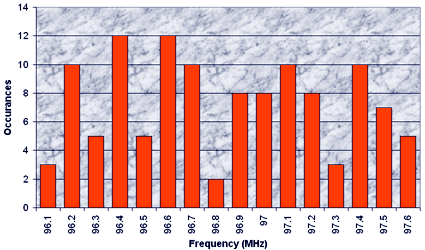
In the lower of these two bands, the frequency 96.8 is only used twice (though it is home to a whacking 250kW BBC Cymru transmission in Wales) and 96.1 and 97.3 are only used 3 times.
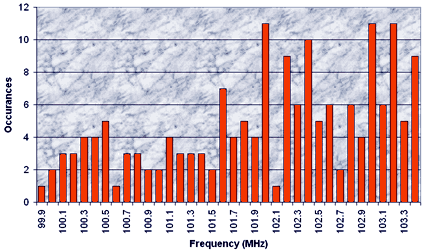
In the range 99.9 to 103.4, 99.9, 100.6 and 102.1 MHz are only used once (though the band 99.9 to 102.0 is repleat with very high powered Classic FM transmitters) and there are several frequencies only used twice across the UK. Finally, in the range 105.0 to 107.9, the frequencies 105.0 and 105.5 MHz are not used at all, and the frequencies 105.1, 105.3, 105.9, and 106.5 MHz are only used once.
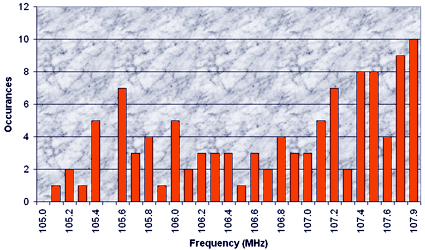
Although this analysis is based on slightly old data (2005) published by Ofcom it does tend to suggest that in addition to 87.5, there are other frequencies which might provide relatively interference free iTrip usage across the UK without needing to re-tune. Unless your local station happens to be one one of these frequencies (or one adjacent to it), I would suggest 99.9, 105.0 (or 105.1) and 106.5 MHz as possible alternatives.
Thursday 21 December, 2006, 15:58 - Pirate/Clandestine
 Was doing a bit of 'Googling', as you do, and came across an attempt by Anthony Page (of Radio Nemesis fame), to start a pirate radio Wiki.
Was doing a bit of 'Googling', as you do, and came across an attempt by Anthony Page (of Radio Nemesis fame), to start a pirate radio Wiki.The page at freeradio.wiki-site.com mostly recounts the history of many of the pirate radio stations who graced the airwaves in the South Yorkshire and Derbyshire areas in the 1980's and 1990's; but it's also not a bad attempt to try and define some of the terms such as 'stereo' and 'link' so it get's an 'A' for effort, though at present probably no more than about a 'C' for achievement. With help from people such as you (yes, you) then maybe it could get a lot better.
There's also a good description of a number of the pirate stations that used to broadcast in that area including:
* Rebel Radio 105.2 (with Scooter Jones)
* Ocean FM 106.3 from Rotherham (which is nowhere near the sea!)
* WLNG 104.9 of Scunthorpe (who get a mention here)
* Radio Britannia from Barnsley with DJ Ken(ny) Crescendo
And no listing would be complete without the infamous ZFM 102.4/105.2/105.5 (mentioned here amongst other places) of Sheffield whose jingles, if I remember rightly, included the classics: 'ZFM - no flies on them' and 'ZFM - it rhymes with phlegm'. Isn't it reassuring to know that radio presentation has moved on...!


